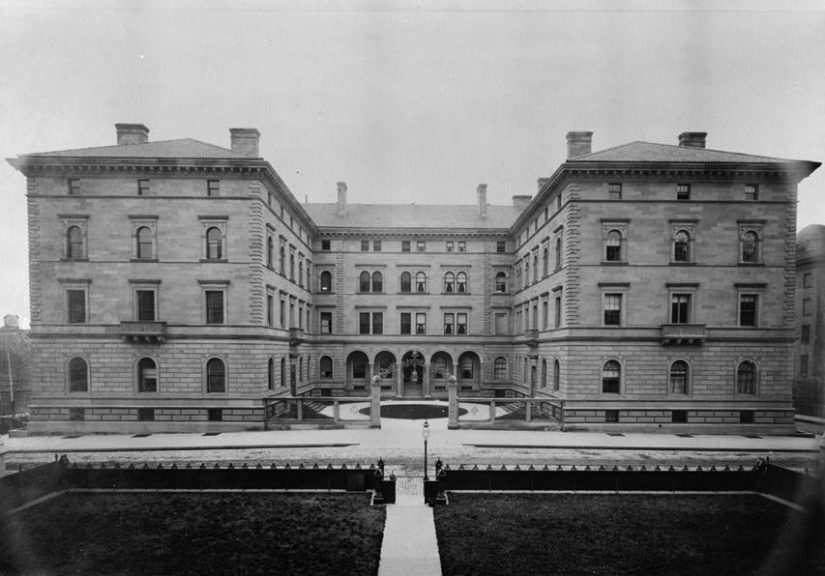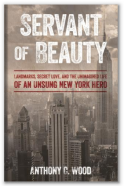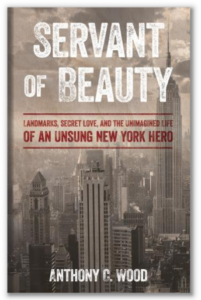
Municipal Art Society
Created in 1893, the Municipal Art Society advocates for excellence in urban design and planning, contemporary architecture, historic preservation, and public art.
The Municipal Art Society (MAS) of New York is a not-for-profit membership organization whose mission is to promote a more livable city. Since 1893, MAS has worked to enrich the culture, neighborhoods, and physical design of New York City. It advocates for excellence in urban design and planning, contemporary architecture, historic preservation, and public art.1
1893: Richard Morris Hunt founds the Municipal Art Society
1903: The Municipal Art Society inaugurates a competition for the street fixture, which later spreads to many other American cities
1950: Municipal Art Society President, Francis Keally, calls for landmarks legislation
January 1960: Municipal Art Society helps to advance the enforcement of aesthetic controls by supporting the New York City Planning Commission’s Zoning Resolution
The Municipal Art Society was founded in 1893 by Richard Morris Hunt (also the organization's first president), the first American architect to receive a degree from the École des Beaux-Arts. Established during the height of the "American Renaissance," the Municipal Art Society stands for beauty, preservation, and dignity. The original aims articulated by the founders were to "present works of art to the city as often as the limited funds would permit," and "to promote public interest in the arts." The Society's interests lie in all aspects of municipal art, an emphasis that proved instrumental to the founding of organizations such as the Fine Arts Federation and the New York City Art Commission.2
The society’s membership is composed of artists, architects, and civic-minded citizens interested in the City’s artistic welfare. MAS has historically been governed by several of New York City's most influential leaders.3
Since its inception, MAS has been a voice for growing concerns about aesthetic regulation in New York City. Whether working alone or partnering with various New York civic organizations, the Municipal Art Society has been an instrumental force in many preservation campaigns. MAS contributed to the formation of the New York City Landmarks Preservation Commission and helped draft legislation leading to the passage of the New York City Landmarks Law.
MAS was very involved in the fight to regulate billboard advertisements. The Municipal Art Society had long been a proponent for using the "police powers" of the federal government for aesthetic regulation.4 Spearheaded by Albert S. Bard, board member and president in 1917, they helped draft legislation that would regulate billboard advertisements on Fifth Avenue. Although the proposed bills regulating billboard advertisement never passed, these legislative efforts would eventually lead to the passage of the Bard Act, making it possible for local municipalities to pass laws regulating private property for aesthetic reasons.
MAS also helped to create New York Landmarks: Index of Architecturally Notable Structures in New York City. MAS worked with the Society of Architectural Historians to create a robust catalog that would raise awareness of the City's rich architectural heritage and form the intellectual basis for landmark designations.5 Whitney North Seymour, Jr., president of MAS at the time, was able to secure funding for this project.6 This index instigated walking tours, radio talks, publications, and exhibits that engaged the public about New York's treasured buildings. The walking tours, led by Henry Hope Reed, in addition to the exhibits, were an ongoing way to highlight neighborhoods and raise awareness of the built environment.7 Furthermore, the index led to the Landmarks of New York plaque program with the New York Community Trust, in which the MAS marked significant buildings with plaques to highlight their importance. The program was used as a basis for many of the first landmarks officially designated by the New York City Landmarks Preservation Commission.
In addition, the MAS was involved in many preservation advocacy battles throughout its history. In 1903, the MAS inaugurated a competition for the street fixture, which later spread to many other American cities. They were also early advocates for the need of a landmarks law in New York City. MAS President, Francis Keally, called for landmarks legislation in 1950, due in part by the demolition of the Rhinelander Houses in Washington Square Park. Furthermore, the MAS advocated on behalf of preserving many landmark buildings, including Castle Clinton, Jefferson Market Courthouse, and the Wyckoff Homestead. In addition, they supported the adaptive reuse of the Jefferson Market Courthouse as a library, and the Villard Houses, where MAS's offices and Urban Center is located.8 MAS was a constant advocate and player in developing legislation in the years leading to the passage of the New York City Landmarks Law. Many of MAS's key leaders (Geoffrey Platt and Harmon Goldstone, for example) were involved in the formation and early years of the Landmarks Preservation Commission.9
Furthermore, MAS played a pivotal role in securing the fate of Grand Central Terminal through the use of publicity campaigns and legal measures.They launched a publicity campaign with Jacqueline Kennedy Onassis as the figurehead to generate nation-wide support to save Grand Central Terminal when it was threatened.10
On another note, the MAS helped to advance the enforcement of aesthetic controls by supporting the City Planning Commission’s Zoning Resolution in January of 1960.11 This resolution established transferable development rights, ultimately affecting the property development rights and land use in New York City. When Penn Central sued the City because regulatory control had prevented them from building a 55-story building on top of Grand Central Terminal, it was argued that these new zoning laws allowed for the company to sell their unused air rights to generate economic profit. The Supreme Court had ruled in favor of the City, because they reasoned the property had to be seen as whole and not parceled out. Since Penn Central had transferable development rights they could still make a profit on their property, therefore the Landmarks Law did not result in a regulatory "taking" of property.
MAS also helped to formulate the 1973 amendments to New York’s Landmarks Law. They formed committees to study the potential of amendments and precedents in other municipalities. They advocated for amendments to the law, including the inclusion of interior landmarks and scenic landmarks, the removal of the moratorium on designations, and the publication of recommendations by the Landmarks Preservation Commission for City-owned landmarks. A Legal Committee drafted a version of the amendments and recommended changes to the New York City Landmarks Preservation Commission and the New York City Law Department.12
For the past few decades, MAS has stayed involved in preservation efforts by engaging in public advocacy, lectures, exhibits, and walking tours. They have participated in recent preservation battles including St. Bartholomew’s, Battery Park, and 2 Columbus Circle. In addition, they helped form important advocacy groups including the Historic Districts Council and Place Matters.
- Municipal Art Society of New York Records
Archives of American Art
1285 Avenue of the Americas, Lobby Level
New York, NY 10019
Tel: (212) 399-5015
Fax: (212) 307-4501 - Greenacre Reference Library and MAS Archives
Municipal Art Society of New York
488 Madison Avenue, Suite 1900
New York, NY 10022
Tel: (212) 935-3960
Email: info@mas.org - Oral Histories with Kent Barwick, Laurie Beckelman, Bronson Binger, Seymour Boyers, Simon Breines, Mosette Broderick, Giorgio Cavaglieri, Frank Gilbert, Diana Goldstein, Harmon Goldstone, Carol Greitzer, Michael Gruen (2008), Michael Gruen (2017), Jack Kerr, Jeffrey Kroessler, Robert Low, Joyce Matz, Gene Norman, Lorna Nowvé, Fred Papert, Otis Pratt Pearsall, Charles A. Platt, Geoffrey Platt, Henry Hope Reed, Joseph Rosenberg, Peter Samton, Frank Sanchis, Whitney North Seymour, Jr., Teri Slater, Jack Taylor, Gabriel Taussig, Anthony M. Tung, Margot Wellington, Norval White, and Ruth Wittenberg
New York Preservation Archive Project - 174 East 80th Street
- New York, NY 10075
- Tel: (212) 988-8379
- Email: info@nypap.org
- “History of the Municipal Art Society of New York,” The Municipal Art Society of New York. Article retrieved 26 March 2016
- Nathalie Dana, The Municipal Art Society: Seventy-Five Years of Service to New York (New York: Municipal Art Society, 1967).
- ”City’s Landmarks Subject of Study,” The New York Times, 24 January 1954.
- Gregory F. Gilmartin, Shaping The City: New York and the Municipal Art Society (New York: Clarkson Potter Publishers, New York 1995), page 138.
- ”Index of Architecturally Notable Structures in New York City,” (New York: MAS, 1953).
- Anthony C. Wood, Preserving New York: Winning the Right to Protect A City’s Landmarks (New York: Routledge, 2008), Chapter Five.
- Gregory F. Gilmartin. Shaping The City: New York and the Municipal Art Society (New York: Clarkson Potter Publishers, 1995).
- Nathalie Dana, The Municipal Art Society: Seventy-Five Years of Service to New York (New York: Municipal Art Society, 1967).
- Anthony C. Wood, Preserving New York: Winning the Right to Protect A City’s Landmarks (New York: Routledge, 2008), page 287.
- ”Celebrities Ride the Rails to Save Grand Central,”The New York Times, 17 April 1978.
- Anthony C. Wood, Preserving New York: Winning the Right to Protect A City’s Landmarks (New York: Routledge, 2008), pages 244-245.
- “City’s Landmarks Subject of Study,”The New York Times, 24 January 1954.




